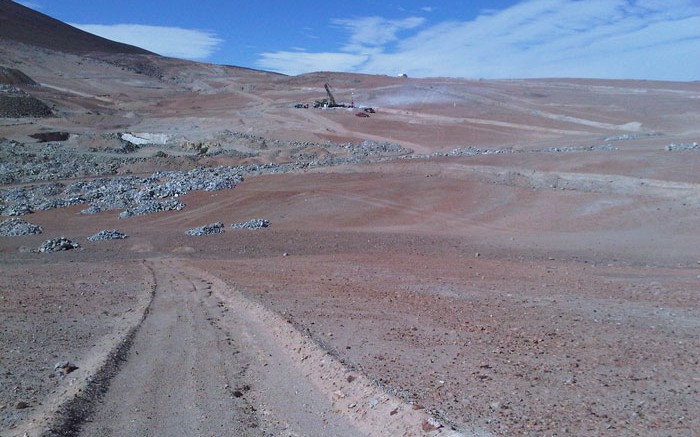Difficult markets and strained balance sheets are dogging junior mining companies across the industry, forcing them to make some hard decisions about how to manage their assets.
IntierraRMG, a mining sector data and consulting company based in Perth, Australia, says that of the nearly 3,500 listed companies in its database, funds raised by the mining sector in the first quarter of 2013 slipped to under US$5.2 billion from almost US$6.8 billion in the last three months of 2012.
There has been a particularly sharp fall in the funds raised by exploration companies, IntierraRMG says, dropping from US$3.4 billion in the three months ended Dec. 31, 2012, to US$1.5 billion in the first quarter of this year.
Coro Mining (COP-T) is just the latest junior that has had to manage and prioritize its portfolio of assets, in a market where it is getting harder to raise funds.
The company said it would seek partners for its three exploration projects in Chile — Payen, El Desesperado and Llancahue — and that it had signed a letter of intent with an engineering firm in Santiago that gives the Chilean company the right to earn up to 50% in Coro’s Berta copper-oxide development project, 30 km southeast of Anglo American’s (AAL-L) Manto Verde copper mine and 30 km southwest of Capstone Mining’s (CS-T) Santo Domingo project.
The modest-sized, near-surface copper oxide deposit has a measured and indicated resource of 8.6 million tonnes grading 0.38% copper at a 0.20% copper cut-off grade and an inferred resource of 1.4 million tonnes grading 0.23% copper. According to the resource estimate released in December 2012, an optimized open-pit resource based on a copper price of US$3 per lb. worked out to 6.1 million tonnes grading 0.4% copper. Coro expects a preliminary economic assessment by the end of September.
“A weak balance sheet facing an onerous property payment schedule has forced Coro to choose between advancing the company’s relatively small but advanced-stage Berta copper oxide project towards production start-up, or focusing on its other potentially large, but earlier-stage [i.e., grassroots] exploration projects in Chile,” Stefan Ioannou of Haywood Securities writes in a research note to clients. “Coro has chosen the former option, and now plans to seek partnerships for its Chilean exploration projects.”
Coro has signed confidentiality agreements with a number of companies that might like to partner on its exploration project portfolio, and Ioannou writes that he would “not be surprised to see potential agreements materialize within the next few months.”
Earlier this year Coro decided to sell Chacay, its early stage porphyry copper prospect in Chile, to a subsidiary of Teck Resources (TCK-T, TCK-N) for US$2.5 million in cash and a 1.5% net smelter return royalty. In early April the two companies cut the cash payment portion of the deal to US$2 million. Chacay is 12 km southeast of Teck’s Relincho copper project.
At the time, Coro said in a press release that the proceeds would be used to advance its Berta, El Desesperado and Payen projects, and chief executive Alan Stephens pointed out that the sale demonstrated the company’s ability to attain non-dilutive financing by selling non-core assets.
In addition to juggling its Chilean properties, Coro owns 100% of the San Jorge copper-gold project in Argentina’s Mendoza state, where provincial government officials in June 2007 outlawed using cyanide and chemicals like sulphuric acid, which are used in leaching copper from oxide ore. In March 2012, Coro came up with an alternative development scenario for the project in a prefeasibility study by ProPipe that involves building a solvent-extraction and electrowinning heap-leach plant outside of Mendoza province in neighbouring (and pro-mining) San Juan province. In 2011, Mendoza provincial authorities refused to ratify San Jorge’s environmental impact declaration.
Undeterred, Coro pushed ahead with a preliminary feasibility study for an alternative development scenario that would involve transporting ore from the mid-sized copper-gold porphyry deposit in Mendoza to a processing facility in San Juan province, about 22 km away. (A rail line would have to be built for the project.)
The prefeasibility study outlined an open-pit crushing and heap-leaching operation that would produce up to 25,000 tonnes, or 55 million lb. copper cathode per year over a decade.
In an update to shareholders on May 8, Coro said the only environmental approval it needs from the Mendoza government is for the proposed railway line to get the ore from the deposit in Mendoza to the proposed processing plant in San Juan. It anticipates approval later this year. “Once granted, no further environmental approvals would be required from the Mendoza government,” the company says, “as the quarry itself and associated crushing facilities have already been approved in the existing environmental impact study.”
Haywood Securities’ Ioannou notes that while Coro’s letter of intent with ProPipe on its Berta project might marginalize “any investor appeal associated with the asset’s near-term copper oxide production potential,” he nevertheless sees it as “prudent in the context of current market conditions, as near-term survival could hold the key to recognizing San Jorge’s future option value, should the political climate in Argentina’s Mendoza province improve.”
Over the last year Coro shares have traded in a range of 10.5¢ to 43¢, and at press time were trading at 14.5¢ per share. The company has 138 million shares outstanding.


Be the first to comment on "Juniors like Coro face tough choices"